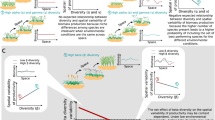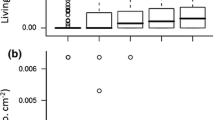Abstract
Repeated patterns, of a type that would be expected to result from limitations to species coexistence (i.e. ‘assembly rules’) were sought in the Park Grass experiment. This classical grassland experiment was sampled in two years, using replicated biomass samples. Variance in a number of measures was examined, and compared to the variance expected under appropriate null models, the latter based on assumptions of no interactions between species. In each case, an assembly rule would result in low variance. Examining variance in species richness between quadrats within a treatment, there was no indication of constraint on species co-occurrences; variance in richness was actually greater than expected under the null model, attributable to environmental variation or perhaps positive interactions between species. However, there was control on biomass, evidenced by variance in total biomass (i.e. over all species) within a treatment being significantly lower than expected under the null model. There was no indication of community structure based on guilds (i.e. functional types). Although there was in 1991 some, non-significant, indication of a constant proportion of species from the legume guild, there was no sign of such an effect in 1992. Searches for intrinsic guilds failed to converge. There was no indication at all of constancy in the proportional representation of guilds by biomass. Thus, there is good evidence for competitive control on plant growth, but none for control of species occurrences. There is no convincing evidence for guild structure in this community at the scale sampled. Possible conflict is discussed between the existence of evidence for temporal stability but the absence of evidence for spatial uniformity. It is concluded that most of the mechanisms proposed for temporal stability will not necessarily lead to control on spatial variation. For many mechanisms, this would depend on the spatial scale examined.
Similar content being viewed by others
References
Aarssen, L. W. 1989. Competitive ability and species coexistence: a ‘plant's-eye’ view. Oikos 56: 386–401.
Abramsky, Z., Bowers, M. A. & Rosenzweig, M. L. 1986. Detecting interspecific competition in the field: testing the regression method. Oikos 47: 199–204.
Aguiar, M. R., Soriano, A. & Sala, O. E. 1992. Competition and facilitation in the recruitment of seedlings in Patagonian steppe. Funct. Ecol. 6: 66–70.
Armesto, J. J. & Pickett, S. T. A. 1985. Experiments on disturbance in old-field plant communities: impact on species richness and abundance. Ecology 60: 230–240.
Bycroft, C. M., Nicolaou, N., Smith, B. & Wilson, J. B. 1993. Community structure (niche limitation and guild proportionality) in relation to the effect of spatial scale, in a Nothofagus forest sampled with a circular transect. N.Z. Jl Ecol. 17: 95–101.
Brown, A. H. F. 1992. Functioning of mixed-species stands at Gisburn, N.W. England. In: M. G. R., Cannell, D. C., Malcolm & P. A., Robertson (eds) The ecology of mixed-species stands of trees [Special publication of the British Ecological Society, 11.], pp. 125–150. Blackwell, Oxford.
Cody, M. L. 1986. Structural niches in plant communities. In: J. M., Diamond & Case, T J. (eds) Community Ecology. pp 381–405. Harper & Row, New York.
Dodd, M. E., Silvertown, J., McConway, K., Potts, J. & Crawley, M. 1994. Stability in the plant communities of the Park Grass experiment: the relationships between species richness, soil pH and biomass variability. Phil. Trans. r. Soc. Lond., B: 346: 185–193.
Hastings, A. 1987. Can competition be detected using species co-occurrence data? Ecology 68: 117–123.
Keddy, P. A. 1990. The use of functional as opposed to phylogenetic systematics: a first step in predictive community ecology. In: Shoichi, Kawano (ed.) Biological approaches and evolutionary trends in plants, pp. 387–406. Academic Press, London.
leishman, M. R. & Westoby, M. 1992. Classifying plants into groups on the basis of associations of individual traits evidence from Australian semi-arid woodlands. J. Ecol. 80: 417–424.
Levin, S. A. 1974. Dispersion and population interactions. Am. Nat. 108: 207–228.
Pielou, E. C. 1975. Ecological diversity. Wiley, New York.
Ryser, P. 1993. Influences of neighbouring plants on seedling establishment in limestone grassland. J. Veg. Sci. 4: 195–202.
Sale, P. F. 1977. Maintenance of high diversity in coral reef fish communities. Am. Nat. 111: 337–359.
Silvertown, J. W. 1987. Ecological stability: a test case. Am. Nat. 130: 807–810.
Silvertown, J. W. & Lovett Doust, J. 1993. Introduction to Plant Population Biology. Blackwell, Oxford.
Silvertown, J. W., Dodd, M. E., McConway, K.,Potts, J. & Crawley, M. J. 1994. Rainfall, biomass variation, and community composition in the Park Grass experiment. Ecology 75: 2430–2437.
Skellam, J. G. 1951. Random dispersal in theoretical populations. Biometrika 38: 196–218.
Thurston, J. M. 1969. The effect of liming and fertilizers on the botanical composition of permanent grassland, and on the yield of hay. In: I. H., Rorison (ed.) Ecological aspects of the mineral nutrition of plants, pp. 3–10. Blackwell, Oxford.
Wilson, J. B. 1987. Methods for detecting non-randomness in species co-occurrences: a contribution. Oecologia 73: 579–582.
Wilson, J. B. 1989. A null model of guild proportionality, applied to stratification of a New Zealand temperate rain forest. Oecologia 80: 263–267.
Wilson, J. B. 1990. Mechanisms of species coexistence: twelve explanations for Hutchinson's ‘Paradox of the Plankton’: evidence from New Zealand plant communities. N. Z. Jl Ecol. 13: 17–42.
Wilson, J. B. 1991. Does vegetation science exist? J. Veg. Sci. 2: 289–290.
Wilson, J. B. 1995a. Variance in species richness, niche limitation, and vindication of patch models. Oikos 73: 277–279.
Wilson, J. B. 1995b. Testing for community structure: a Bayesian approach. Folia Geobot. Phytotax., 30: 461–469.
Wilson, J. B. & Gitay, H. 1995a. Community structure and assembly rules in a dune slack: variance in richness, guild proportionality, biomass constancy and dominance/diversity relations. Vegetatio 116: 93–106.
Wilson, J. B. & Gitay, H. 1995b. Limitations to species coexistence: evidence for competition from field observations, using a patch model. J. Veg. Sci. 6: 369–376.
Wilson, J. B. & Roxburgh, S. H. 1994. A demonstration of guild-based assembly rules for a plant community, and determination of intrinsic guilds. Oikos 69: 267–276.
Wilson, J. B. & Sykes, M. T. 1988. Some tests for niche limitation by examination of species diversity in the Dunedin area, New Zealand. N. Z. Jl Bot. 26: 237–244.
Wilson, J. B. & Watkins, A. J. 1994. Guilds and assembly rules in lawn communities. J. Veg. Sci. 5: 591–600.
Wilson, J. B. & Whittaker, R. J. 1995. Assembly rules demonstrated in a saltmarsh community. J. Ecol. 83: 801–807.
Wilson, J. B., Gitay, H. & Agnew, A. D. Q. 1987. Does niche limitation exist? Funct. Ecol. 1: 391–397.
Wilson, J. B., Roxburgh, S. H. & Watkins, A. J. 1992. Limitation to plant species coexistence at a point: a study in a New Zealand lawn. J. Veg. Sci. 3: 711–714.
Wilson, J. B., Allen, R. B. & Lee, W. G. 1995. An assembly rule in the ground and herbaceous strata of a New Zealand rainforest. Funct. Ecol. 9: 61–64.
Zobel, K., Zobel, M. & Peet, R. K. 1993. Change in pattern diversity during secondary succession in Estonian forests. J. Veg. Sci. 4: 489–498.
Author information
Authors and Affiliations
Rights and permissions
About this article
Cite this article
Wilson, J.B., Crawley, M.J., Dodd, M.E. et al. Evidence for constraint on species coexistence in vegetation of the Park Grass experiment. Vegetatio 124, 183–190 (1996). https://doi.org/10.1007/BF00045493
Received:
Accepted:
Issue Date:
DOI: https://doi.org/10.1007/BF00045493




